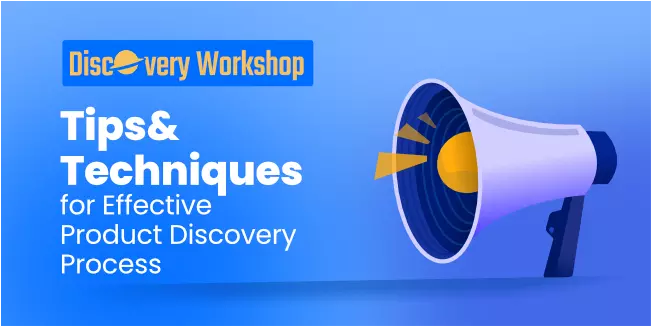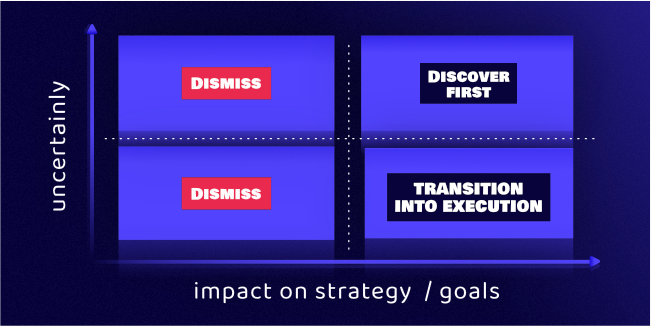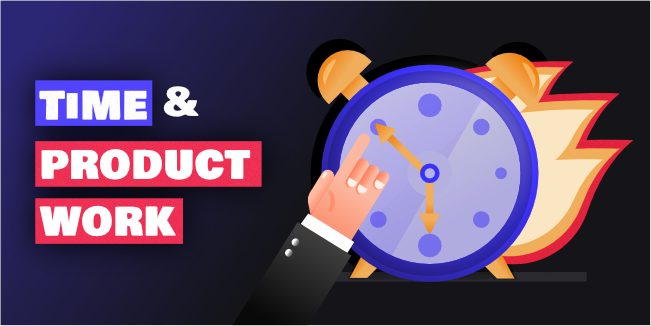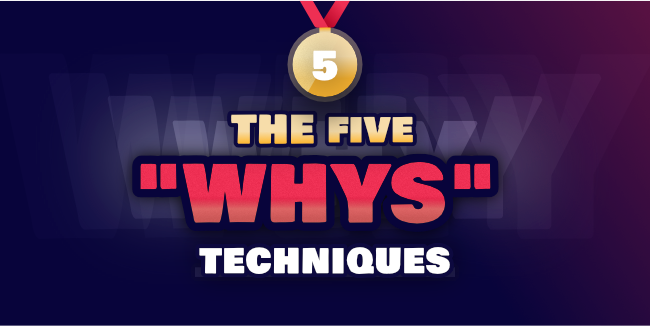discoveryphase
discovery
discoveryprocess
discoveryworkshop
Tips and Techniques for Effective Product Discovery Process

We present to you another article from the Discovery Workshop series. Once you know what Product Discovery and Discovery Process are, you may have mixed feelings about the level of complexity of the entire operation.
For this reason, we have come up with an article containing many clever and proven tips and techniques that will make the Product Discovery or Discovery Process even more understandable and easier to master.
Define the scope of your discovery process
The first step is to determine the scope of your process. What do you wish to discover? How will you make decisions? Make as detailed a description as possible. For this reason, you'll be more prepared and better able to concentrate your efforts. You'll know that you've found the correct product to move into product delivery because of this. Some things you may want to consider:
- The pain points and problems you're trying to solve
- Your target market
- Your competition
- The feasibility of your proposed solution
- Your product's unique value proposition.
The most valuable features, i.e., a few words about prioritization opportunities
Simple Effort-Impact-Scoring methodologies fail—because you don't know what type of solution you should score. Discovering products is about lowering uncertainty and boosting the confidence to invest in developing a certain product. It can be challenging for a product manager, but you may assess the uncertainty, and you'll have a much better idea of which concepts you need to explore during Product Discovery further.

You'll see where your future goals may be found on the top right. Everything on the lower right should be viewed from a Delivery capacity standpoint. Prioritizing possibilities may seem difficult to you—and that's OK. It isn't about being 100% accurate; it's about developing a common understanding among your team and organization about which concepts to do. That method is helpful and can be a significant part of product management.
Right people in the right place
In the era of product development, product discovery is a team sport. You aim to vet new concepts for a minimal viable product. Therefore you'll want to involve the appropriate people in your project. To ensure that you have sufficient of their time, I recommend forming a product discovery team that includes:
UX designer, developer, tester (development team), CTO, and other stakeholders must be involved in developing a new software product. For example, marketing, sales, and support staff are key players.
Involving others in the process allows you to tap into their knowledge and gain support for critical decisions like choosing a specific market sector and distinct characteristics, which speeds up the procedure. The greatest approach to come up with new ideas is through cross-functional collaboration. For example, a UX designer might assist you in observing and talking to users (to gather customer feedback); a CTO may advise you on technical feasibility and identify technological risks; a sales rep may connect you with possible customers and help you research competition. As a result, Discovery Workshops are outstanding at performing cross-functional collaboration. Our workshops leverage tech experience to maximize business results thanks to our team members, who participate in the meetings with clients.
Potential solutions? No! Focus on problem validation first!
Your product discovery effort should concentrate on the value proposition, target audience, business objectives, business model, and standout features of the product. It's fine to assess significant user interaction and architecture concerns as part of the discovery process. It would help if you aimed to reduce the danger of creating something no one wants or needs, not figure out how it works. However, after you've successfully validated the issue, the bulk of UX design, user flows and user stories writing, and technology work should be completed.
That is why we have a series of workshops. The first is the Discovery Workshop, where we work with you to validate the problem. Thanks to 100 workshops, we know how to wisely help you build a product. The next stage of work is the opportunity to participate in the Design Workshop.
Time and product work
Minimize time spent on research to speed up the time it takes to get a product to market. There is no way to ensure that the new product or next version is correct. It would help if you quickly strive for a reasonable enough outcome and adjust it to the market.

However, please don't jump into building the real thing too fast, and don't go at it alone. Test and address key product and business model assumptions and risks in an iterative way by using observations, interviews, surveys, and prototypes to explore the fundamental concepts and to gather user feedback.
You are not in a position to create the actual solution if you can't confidently claim why people will use your product, who those individuals are, what sets your product apart from the competition, and why it's worth investing time and money into developing and delivering it. Continue exploring (persevere or pivot), or move on to another product concept.
Get in touch with customers
The essential aspect of creating a successful product is the user. They will use the product. Building a solid business model and sophisticated user interactions is pointless if you don't understand your users' problems, what works for them, or what doesn't. If your product isn't wanted or can't be used, you'll have difficulty monetizing and achieving product success.
To be successful with product discovery, I believe that you, the person in charge of the product, should conduct user research and gain a thorough knowledge of the user demands. Reach out to your target consumers face-to-face, whether online or onsite. You can consider conducting customer interviews to gather user feedback to see that it pays off in a great minimum viable product.
Enter the timeframe for activities
Knowing how much time and effort will be required to complete the necessary discovery work may be difficult, especially when you're developing a new product and making a substantial change to an existing one, such as extending its life cycle. Fortunately, there is a simple solution: set a timetable for your product discovery efforts. A timebox is a duration that can't be extended. The work stops after the time box, and you evaluate what was accomplished. Suppose the job hasn't been finished and your product strategy and business model continue to contain significant risks. In that case, you have two alternatives: add another time constraint and perhaps pivot or stop the work.
Continuous discovery
While "product discovery" is most commonly used to signify the initial stage of a new product development process, it should not be restricted to new products. As your product progresses and matures, its value proposition, market, distinctive features, and business model will change. You must keep up with continuous product discovery and evaluation and your product, roadmap, and business model to maintain and develop it.
Product discovery techniques
Impact Mapping
Impact Mapping is a highly successful tool for Product Teams to make sense of all the data they've collected and then make trade-offs. Levels are linked to one of the primary elements that a Product Team must tackle as they progress through Product Discovery. It is simpler to manage teams working through the problem and solution space. This technique allows you to create value for teams in contextualizing strategic counsel, research evidence, ideation outcomes, and experiment results to make data-informed judgments. The middle of the road is often a trap for project managers and other executives. Because projects are typically done at multiple levels, teams (and leaders) may avoid jumping straight from high-level company impacts (such as rising income or user activity) into looking for answers. Making tactical choices without losing sight of the bigger picture of how one solution fits into goals.
The idea validation grid
The meticulous work of organizing and conducting experiments necessitates its framework and location. And it's pointless to try to go straight to the best validation technique you heard about, as it does not make sense. Instead, it would help if you built a case for why a certain method is appropriate for the issues surrounding an idea you're dealing with. It isn't just helpful in having a solid argument about your resources; it also helps guarantee high-quality discussions with other domain experts at your firm about selecting the best experiment.
A high-level account of the generated concept, perhaps in the form of decision-making criteria. We may use it to indicate an idea's priority and our changing confidence in listing and ranking the assumptions about it (that is, we explain which actions or outcomes the notion would need to achieve to succeed ultimately).
Tying this back to the behavioral change we want to promote. The Idea Validation Grid differs from other frameworks. Its emphasis is on the concept and value it tries to create, rather than an experimentation focus. We experimented with validating our assumptions regarding the user Outcome and any findings and conclusions in the form of the following actions.
The five ‘whys’ techniques

Customers can offer unique insights on elements that are missing from your product. However, they can't advise you on the greatest solution; that's for your team's design thinking to handle. One easy method to start is by using the five whys.' The quest for an answer begins with reframing the problem.
The idea is to attack a surface-level issue or client request until you've discovered the source of the problem. It allows you to create a more general hypothesis that may be addressed holistically rather than meeting little feature demands without an established overall product vision.
Let's assume that your clients have requested a feature that allows them to assign tasks to their team members.
- Why? Customers must exit our app to distribute work among themselves on Slack.
- Why? Customers cannot collaborate directly in our app.
- Why? We didn't include in-app collaboration tools.
- Why? We haven't placed a high value on team collaboration in our roadmap.
- Why? We had no idea that our clients valued collaboration.
Your team has discovered a much bigger issue to address from a minor product suggestion: would a collection of collaboration features be enough to finish your product solution? It would be the starting point for an excellent hypothesis—and it could even lead to the formation of a new component of your product.
Conclusion
To build a great product, you need to understand your audience and what they want. You also need to be able to deliver true value. Finally, you need to be able to stay on topic and keep your discovery process clear. By following these tips, you should be able to produce a high-quality process that will engage and inform your team.
Getting to know the Product Discovery and Discovery Process much better makes it much easier to create them. When the whole idea and directions are organized, it will be much easier to go to the stage of idea validation. It is the next critical stage of our study, about which we have created an article as part of the Discovery Workshop series.

This article is part of our Discovery Workshop series
What is Product Design? What is the Product Discovery and Product Discovery Process? Now readingTips and Techniques for Effective Product Discovery Process Idea Validation in Practice Product Roadmap - how to write user stories and user flows? How to choose a tech stack for your project? How to create a project timeline? How to create a project budget? Functional Requirements Document for your Product What is a Prototype? Build your MVP (Minimum Viable Product) the right way - step by step guide by mDevelopers